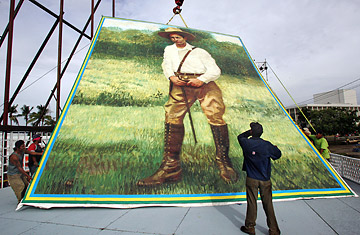
Workers fix a banner of Nicaragua's hero Augusto Cesar sandino at the Faith Square in Managua.
The ghosts of the past have an enduring power in Nicaragua, which is why the legendary nationalist guerrilla general Augusto Sandino has become the object of a political tug-of-war between the government and its naysayers. Sandino died in 1934, but his mantle — and iconic sombrero — has long been claimed by the Sandinista Front, which overthrew the dictatorship of Anastasio Somoza in 1979. The Sandinistas, of course, are back in power under President Daniel Ortega, but a group of old-school Sandinista revolutionaries charge that Ortega has betrayed the movement's leftist principles — and they want Sandino (and his hat) back, to use as the symbol of their revived opposition movement.
Waving orange-and-yellow flags adorned with the famous outline of Sandino's iconic headgear — the most recognizable silhouette in Nicaragua — a group of left-wing protesters has taken to the streets, chanting old Sandinista slogans from the 1970s to rally others against what they claim is a return to dictatorship under Ortega. While the protest movement has grown quickly in recent weeks, fueled mostly by concerns over Nicaragua's deteriorating political and economic situation, it has also rekindled nostalgia for the old revolutionary symbols and songs that have since become propaganda tools for an unpopular government.
Sandino's name was first invoked by the ruling Sandinista National Liberation Front (FSLN) in the 1960s, when it was a clandestine guerrilla movement. Its purpose was to establish a continuity with the popular nationalist revolutionary movement of the 1920s. While President Ortega may still imagine himself to be Sandino's heir, many of his former comrades say today's FSLN is nothing more than a vehicle for Ortega's personal ambitions, and has little claim to the ideals of its revolutionary past.
"Sandinismo is something that is much more profound than what the Sandinista Front represents today," says former Sandinista Vice President and movement intellectual, Sergio Ramirez, who defected from the FSLN in 1995 to start the Sandinista Renovation Movement (MRS). "The Sandinismo that led to the triumph of the revolution has dispersed into distinct movements and many forms of expression."
The ruling Sandinistas, however, are having none of it. Earlier this month, the government cancelled the electoral status of the MRS, charging that it hadn't complied with all the technical requirements to register for upcoming municipal elections. The MRS claims the decision was a political move to eliminate challenges to Ortega. Excluded from the polls, the dissident Sandinistas have taken their challenge to the streets — Ortega's traditional territory — and challenge him for the historical memory and mystica of the Sandinista revolution.
And what can't be won on the streets will be fought in the realm of intellectual property: Famed revolutionary singer-songwriter Carlos Mejia Godoy, who wrote the soundtrack to the Sandinista revolution in the 1970s and '80s, told the government last week it can no longer play his music at official events. Mejia, who has had all his 200-plus songs copyrighted in Spain, told TIME that the Sandinista Front that had inspired his music 30 years ago no longer exists. "There aren't even any ashes left of that political organization, which has sent all of its values to the garbage dump of history," he said.
The government's response to Mejia's complaint came in a rambling letter from First Lady Rosario Murillo, an eccentric poet who serves as the government's chief of protocol, and dabbles in songwriting herself — her greatest hits include upbeat Sandinista remixes to John Lennon's "Give Peace a Chance" and Bob Marley's "One Love." Mejia could not claim ownership of the songs, she argued, because the folk singer had simply been "an instrument for the divine rhythm" that came through his body "from an unknown, sacred place." Murillo then showcased her own ability to channel the divine rhythm by arranging a full orchestra remix of Mejia's famous revolutionary hymn "La Consigna" at a government rally on June 21 — a week after he told the ruling party to refrain from using his music. "The government is trying to confiscate my music," Mejia said, adding that his lawyers are already working on a case.
On the streets, the battle over Sandinista symbols has led to a kind of semiotic chaos in which the government and opposition groups use the same images to convey very different messages. The ruling party pays homage to national hero Rigoberto Lopez Perez, who assassinated former dictator Anastasio Somoza Garcia, but dissidents paint graffiti with the message "Rigoberto come back!" to underscore the strength of their disdain for the current president. While the government plasters the country with posters touting Ortega's fealty to Sandino, anti-government protesters wave signs proclaiming "Sandino would never have been a Danielista."
Sandinista historian Aldo Diaz Lacayo says the image of Sandino is intimately linked to the Nicaraguan identity because "there is no one greater who has fought in the defense of national sovereignty and against foreign intervention." A Nicaraguan peasant who led guerrilla raids against the U.S. military occupation of Nicaragua in from 1927-1932, Sandino has been elevated in the national mythology to superhuman status, and his writings are revered as scripture among Sandinistas — and just as with scripture, virtually everyone can find things in Sandino's writings to reinforce their own political positions. Diaz Lacayo notes that even the right wing has attempted to claim Sandino by arguing that his writings prove "Sandino himself wasn't even a Sandinista."
For the protesters on the street, reclaiming Sandino is about debunking Ortega's myth, and revealing that the emperor has no clothes. "This is part of the struggle, to recover these symbols and give them democratic legitimacy once again," Ramirez said. "They have lots of power, lots of strength. They have the power to convoke others. Sandino, his name, his hat, the symbol."
